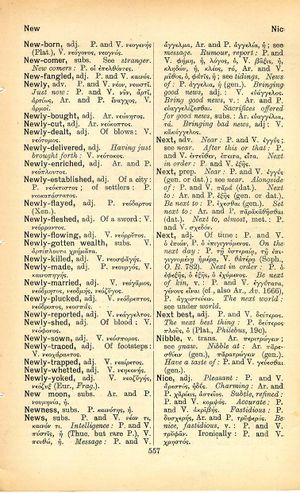next: Difference between revisions
From LSJ
m (Text replacement - "<b class="b2">Av.</b>" to "Av.") |
m (Text replacement - "<b class="b2">P</b>," to "P.") |
||
| Line 12: | Line 12: | ||
<b class="b2">Next to, almost</b>, met.: P. and V. [[σχεδόν]]. | <b class="b2">Next to, almost</b>, met.: P. and V. [[σχεδόν]]. | ||
'''adj.''' | '''adj.''' | ||
Of time: P. and V. ὁ ἐπιών, | Of time: P. and V. ὁ ἐπιών, P. ὁ ἐπιγιγνόμενος. | ||
<b class="b2">On the next day</b>: P. τῇ ὑστεραίᾳ, τῇ ἐπιγιγνομένῃ ἡμέρᾳ, V. θἀτέρᾳ (Soph., ''O.R.'' 782). | <b class="b2">On the next day</b>: P. τῇ ὑστεραίᾳ, τῇ ἐπιγιγνομένῃ ἡμέρᾳ, V. θἀτέρᾳ (Soph., ''O.R.'' 782). | ||
<b class="b2">Next in order</b>: P. ὁ. [[ἐφεξῆς]], ὁ [[ἑξῆς]], ὁ ἐχόμενος. | <b class="b2">Next in order</b>: P. ὁ. [[ἐφεξῆς]], ὁ [[ἑξῆς]], ὁ ἐχόμενος. | ||
Revision as of 15:27, 6 November 2019
English > Greek (Woodhouse)
adv.
Near: P. and V. ἐγγύς; see near. After this or that: P. and V. ἐντεῦθεν, ἔπειτα, εἶτα. Next in order: P. and V. ἑξῆς. prep. Near: P. and V. ἐγγύς (gen. or dat.); see near. Alongside of: P. and V. παρά (dat.). Next to: Ar. and P. ἑξῆς (gen. or dat.). Be next to: P. ἔχεσθαι (gen.). Set next to: Ar. and P. παρακαθῆσθαι (dat.). Next to, almost, met.: P. and V. σχεδόν. adj. Of time: P. and V. ὁ ἐπιών, P. ὁ ἐπιγιγνόμενος. On the next day: P. τῇ ὑστεραίᾳ, τῇ ἐπιγιγνομένῃ ἡμέρᾳ, V. θἀτέρᾳ (Soph., O.R. 782). Next in order: P. ὁ. ἐφεξῆς, ὁ ἑξῆς, ὁ ἐχόμενος. Be next of kin, v.: P. and V. ἐγγύτατα, γένους εἶναι (cf., also Ar., Av. 1666), P. ἀγχιστεύειν. The next world: see under world.

